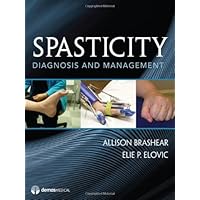
Average Reviews:

(More customer reviews)First, a bit of a disclaimer; I have coauthored an article with one of the two primary authors (1). Also, this book is published by the same publisher as my book, Stronger After Stroke.
There are great reasons to have this book. Much of the book I've yet to digest (the book is nearly 350 large pages). But everywhere I turn, I learn something new. The section on Chemoneurolysis has an amazing breakdown of the cost of phenol vs. more expensive nerve blocks. Ch. 14 ("Emerging technologies...") with its emphasis on reestablishment of cortical control is worth the price of admission. Thomas Watenabe's chapter is concise and well written. The photographs throughout are instructive.
Please note the following LONG paragraph is specifically about chapter 13, my primary area of interest.
Much of chapter 13 (The Role of PT/OT) is a scatter-shot of reviews of journal articles. On more than one occasion the authors include research on devices purported to reduce spasticity that are coauthored by people with a financial COI. Editing issues in Ch. 13: The sentence "The intensity of the stretch provided can be modulated by controlling the ankle at which the table is set at." The dangling "at" and "ankle" for "angle" is an issue of editing that should have been picked up by the publisher. (Authors, please note; in the article by Bakhtiary (2) there was no NMES-only group). The Ashworth, a test (for the sake of brevity) of resistance of soft tissue, is discussed in this chapter, as well. The Ashworth scale is available in this chapter, as well as in several other chapters. The authors of Ch 13 state that there are no "...standardized procedures for patient positioning, scoring, or overall test implementation." Still, having used the Ashworth in many clinical trials, there's at least one truth: A baseline score may be best garnered in supine. Just as baseline BP is best garnered at rest, baseline testing of spasticity is also best measured at rest. Everything that falls under the category of "spasticity" (resistance to stretch, hyperreflexia, etc.) is reduced in supine because contraction of muscles, including the trunk muscles during sitting, will increase the score. The varying amounts of muscle contraction needed by different people during sitting provides a clear confound to standardization. There is a portion on stretching which the authors rightly suggest is over-rated as a hedge against the long term effects of spasticity. It would have been helpful to include mention the article (a systematic review) that best drives this point home (3). I should point out that Watenabe's article (4) which appears to also have had great impact on Ch. 13, has significantly guided my perspective on spasticity and its reduction. For clinicians involved in OT and PT, I'd suggest that article as a serious tool for helping patients.
But, again, this is an essential book for anyone treating or testing and spasticity. One reason to own it is that, because its focus is pristine (in this regard, its stands alone) it provides the only comprehensive perspective in print. It manages to span the width and breadth of the complexity of spasticity. For instance, there's a whole section on assessing spasticity. For clinicians treating spasticity, assessment tools that provide quantifiable data are essential because without quantifiable data treatment efficacy is questionable.
There are chapters on spasticity as it affects SCI, MS, stroke, TBI and more. There's a section on treatment, measurement and the basic science of spasticity.
This book manages to be both highly technical and highly readable. Tons of clichés come to mind; it's a must-have; it's an essential book; it's the only book of its kind.
1.Page SJ, Elovic E, Levine P, Sisto SA. Modified constraint-induced therapy and botulinum toxin A: a promising combination. Am J Phys Med Rehabil 2003 Jan;82(1):76-80.
2.Bakhtiary AH, Fatemy E. Does electrical stimulation reduce spasticity after stroke? A randomized controlled study. Clin Rehabil. 2008 May;22(5):418-25.
3.Bovend'Eerdt TJ, Newman M, Barker K, Dawes H, Minelli C, Wade DT. The effects of stretching in spasticity: a systematic review. Arch Phys Med Rehabil. 2008 Jul;89(7):1395-406. Epub 2008 Jun 13. Review. PubMed PMID: 18534551.
4.Watanabe T. The role of therapy in spasticity management. Am J Phys Med Rehabil. 2004 Oct;83(10 Suppl):S45-9. Review. PubMed PMID: 15448577.
Click Here to see more reviews about: Spasticity: Diagnosis and Management
Click here for more information about Spasticity: Diagnosis and Management

No comments:
Post a Comment